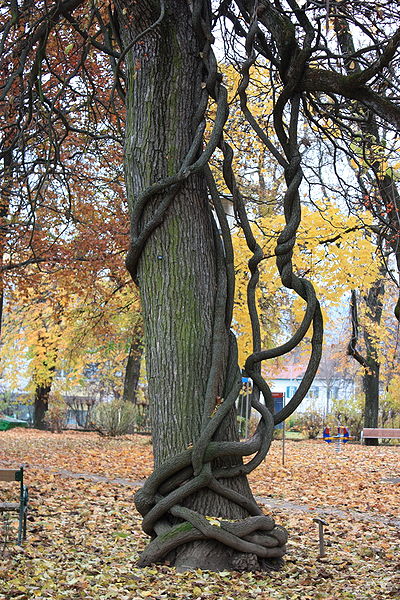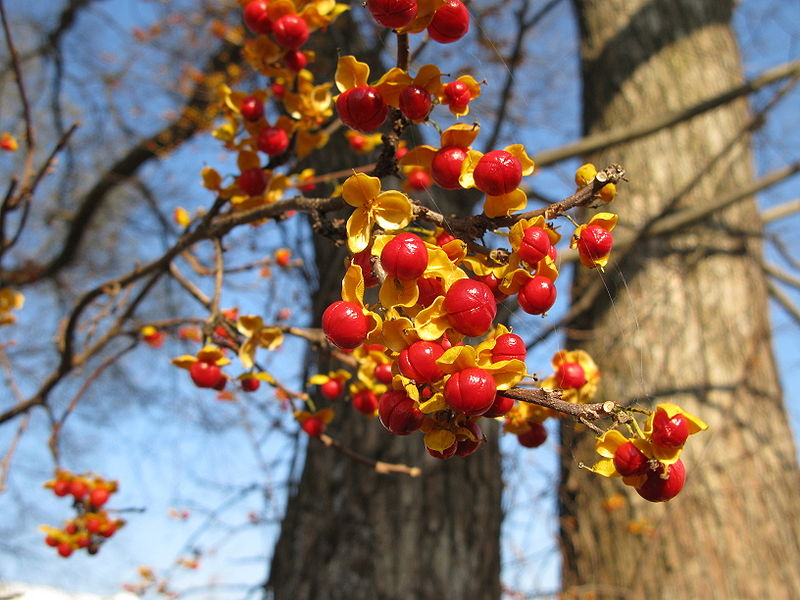 |
|
http://commons.wikimedia.org/wiki/User:Mefusbren69 |
 |
| http://commons.wikimedia.org/wiki/User:Qwert1234 |
Translate this page:
Summary
Physical Characteristics

 Celastrus orbiculatus is a deciduous Climber growing to 12 m (39ft) by 12 m (39ft) at a fast rate.
Celastrus orbiculatus is a deciduous Climber growing to 12 m (39ft) by 12 m (39ft) at a fast rate.
See above for USDA hardiness. It is hardy to UK zone 4. It is in flower from July to August, and the seeds ripen from November to February. The species is dioecious (individual flowers are either male or female, but only one sex is to be found on any one plant so both male and female plants must be grown if seed is required). and is pollinated by Bees.
Suitable for: light (sandy) and medium (loamy) soils, prefers well-drained soil and can grow in nutritionally poor soil. Suitable pH: mildly acid and neutral soils. It can grow in full shade (deep woodland) semi-shade (light woodland) or no shade. It prefers moist soil.
UK Hardiness Map
US Hardiness Map
Synonyms
C. articulatus. Thunb.
Plant Habitats
Woodland Garden Dappled Shade; Shady Edge; not Deep Shade; Hedge;
Edible Uses
Edible Parts: Leaves
Edible Uses:
Young leaves - cooked[105, 177].
References More on Edible Uses
Medicinal Uses
Plants For A Future can not take any responsibility for any adverse effects from the use of plants. Always seek advice from a professional before using a plant medicinally.
Antiphlogistic Antirheumatic Cancer Depurative Tonic
The roots, stems and leaves are antiphlogistic, antirheumatic, depurative and tonic[147, 218]. A decoction of the roots and stems is used internally whilst the crushed fresh leaves are used for external applications[147]. The plant is used in the treatment of paralysis, numbness of the four extremities, headache, toothache, spontaneous abscess formation and snake bites[147]. Many plants in this genus contain compounds of interest for their antitumour activity[218].
References More on Medicinal Uses
The Bookshop: Edible Plant Books
Our Latest books on Perennial Plants For Food Forests and Permaculture Gardens in paperback or digital formats.

Edible Tropical Plants
Food Forest Plants for Hotter Conditions: 250+ Plants For Tropical Food Forests & Permaculture Gardens.
More

Edible Temperate Plants
Plants for Your Food Forest: 500 Plants for Temperate Food Forests & Permaculture Gardens.
More

More Books
PFAF have eight books available in paperback and digital formats. Browse the shop for more information.
Shop Now
Other Uses
References More on Other Uses
Cultivation details
Prefers a deep loamy soil[1] but succeeds in most soils so long as they are not too shallow[202]. Succeeds in full or partial shade[188]. Plants flower more freely if their top-growth is in the sun[182]. Requires a humus-rich soil if it is to be at its best[219]. A very ornamental plant[1], it is hardy to about -25°c[200]. A rampant climber, it requires ample space and is best grown into an old tree[1, 200. It climbs by means of twining and also by the young stems having prickles[182]. Plants do not normally require pruning[219]. Plants in this genus are notably resistant to honey fungus[200]. Plants are usually dioecious, in which case male and female plants must be grown if seed is required, but hermaphrodite forms are in cultivation[11, 182, 200].
References Carbon Farming Information and Carbon Sequestration Information
Temperature Converter
Type a value in the Celsius field to convert the value to Fahrenheit:
Fahrenheit:
The PFAF Bookshop
Plants For A Future have a number of books available in paperback and digital form. Book titles include Edible Plants, Edible Perennials, Edible Trees,Edible Shrubs, Woodland Gardening, and Temperate Food Forest Plants. Our new book is Food Forest Plants For Hotter Conditions (Tropical and Sub-Tropical).
Shop Now
Plant Propagation
Seed - gather when ripe, store in dry sand and sow February in a warm greenhouse[78]. Three months cold stratification leads to a higher germination rate[113]. Remove the flesh of the fruit since this inhibits germination[113]. Germination rates are usually good[78]. When they are large enough to handle, prick the seedlings out into individual pots and grow them on in a greenhouse for at least their first winter. Plant them out into their permanent positions in late spring or early summer, after the last expected frosts. Cuttings of half-ripe wood, July/August in a frame[188]. Layering in August of the current seasons growth. Takes 12 months[78]. Root cuttings, 6mm thick 25mm long in December. Plant horizontally in pots in a frame[78].
Other Names
If available other names are mentioned here
Preferred Common Name: Asiatic bittersweet. Other English: Asian bittersweet; Chinese bittersweet; Japanese bittersweet; oriental bittersweet. Germany: Baumwürger, Rundblättriger. Japan: tsuru-ume-mo-doki. New Zealand: climbing spindleberry. USA: round-leaved bittersweet. Others: Baiwanye, Man she teng, Nobaktonggul.
Native Range
TEMPERATE ASIA: Mongolia, Russian Federation (Primorye, Sakhalin), China (Anhui Sheng, Gansu Sheng, Hebei Sheng, Heilongjiang Sheng, Henan Sheng, Hubei Sheng, Jiangsu Sheng, Jiangxi Sheng, Jilin Sheng, Liaoning Sheng, Nei Mongol Zizhiqu, Shaanxi Sheng, Shandong Sheng, Sichuan Sheng, Zhejiang Sheng), Korea, Japan (Hokkaidô, Honshu, Kyushu, Shikoku)
Weed Potential
Right plant wrong place. We are currently updating this section.
Please note that a plant may be invasive in one area but may not in your area so it's worth checking.
Considered to be an invasive species in eastern North America. As a fast growing, twining vine, C. orbiculatus is a threat to other plants through constriction of the woody stems it climbs upon leading to slowed growth and eventually mechanical failure, over-topping and shading out plants beneath it, and outright competition for resources [1d].
Conservation Status
IUCN Red List of Threatened Plants Status : This taxon has not yet been assessed.

Growth: S = slow M = medium F = fast. Soil: L = light (sandy) M = medium H = heavy (clay). pH: A = acid N = neutral B = basic (alkaline). Shade: F = full shade S = semi-shade N = no shade. Moisture: D = dry M = Moist We = wet Wa = water.
Now available:
Food Forest Plants for Mediterranean Conditions
350+ Perennial Plants For Mediterranean and Drier Food Forests and Permaculture Gardens.
[Paperback and eBook]
This is the third in Plants For A Future's series of plant guides for food forests tailored to
specific climate zones. Following volumes on temperate and tropical ecosystems, this book focuses
on species suited to Mediterranean conditions—regions with hot, dry summers and cool, wet winters,
often facing the added challenge of climate change.
Read More
Expert comment
Author
Thunb.
Botanical References
1158200
Links / References
For a list of references used on this page please go here
Readers comment